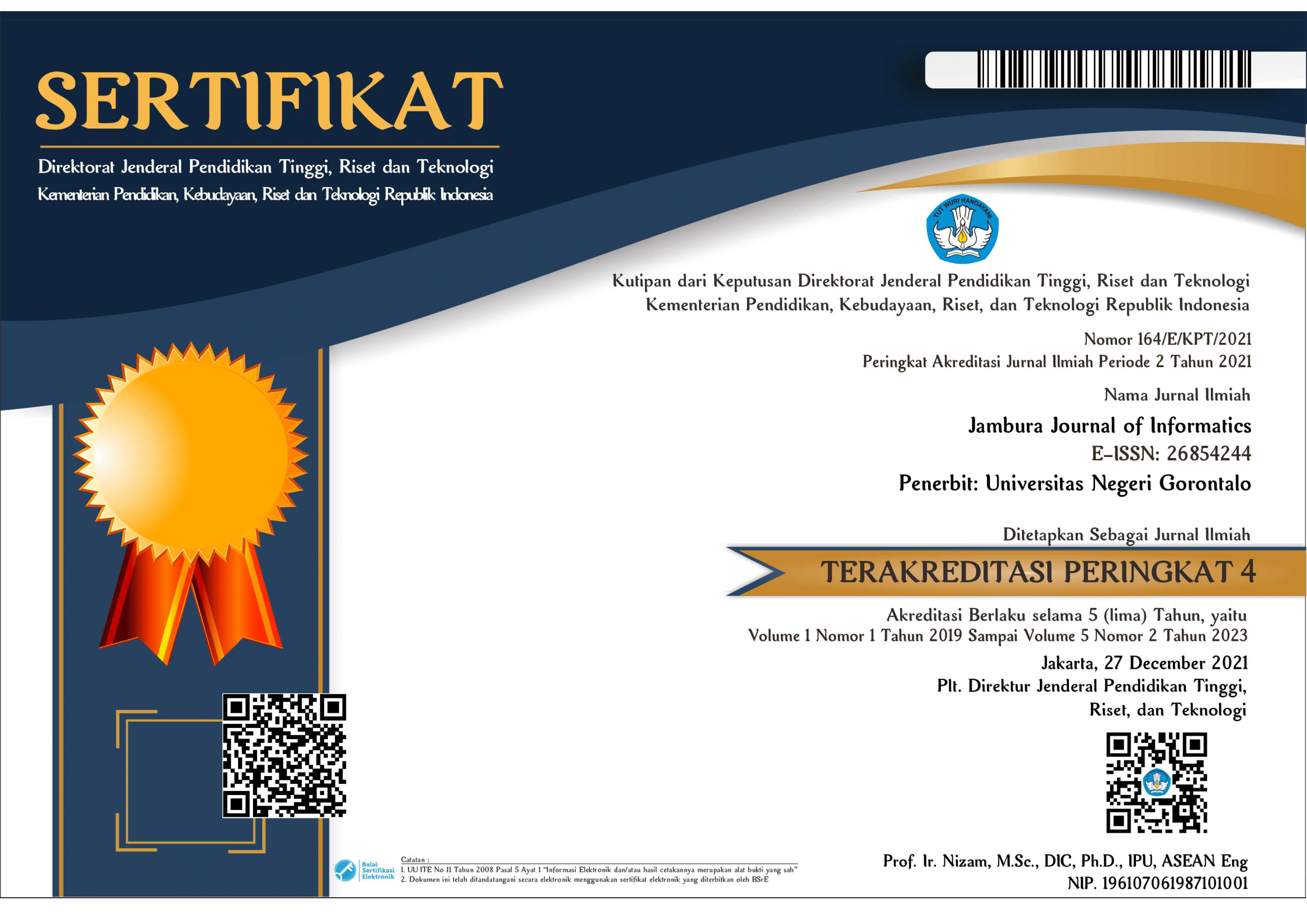Pengembangan Sistem Informasi Berbasis Web Untuk Pendistribusian Gas LPG
Abstract
Liquefied Petroleum Gas (LPG) in 3kg packaging is reserved actually for poor and SMEs, yet the gas is also utilized by well-off people and business owners. This occurs because of the absence of computerized surveillance systems of the gas distribution by the agent and outlet. This study aimed to develop a web-based system of 3kg Liquefied Petroleum Gas information distribution in PT.P(Persero) Gorontalo; a prototype model was used to develop the system. This research resulted in a system that provides access rights for administrators to be able to input required data, such as customer data, outlet data, outlet distribution data, and customer distribution data. The systems also help the process of 3kg Liquefied Petroleum Gas distribution and PT.P(Persero) Gorontalo in terms of the supervision process.
Keywords
Full Text:
PDF (Bahasa Indonesia)References
Aróstegui, M. N. P., Sánchez, F. B., & Molina, V. B. (2015). Exploring the relationship between information technology competence and quality management, BRQ Business Research Quarterly, 18, 4-17. http://dx.doi.org/10.1016/j.brq.2013.11.003
Alex. (2019). Rapat TPID, Ryan sorot penyaluran elpiji 3 kg tak tepat sasaran. Retrieved from https://hulondalo.id/ diakses tanggal 18 Oktober 2020.
Alter, S. (2008). Defining information systems as work systems: implications for the IS field. European Journal of Information Systems, 17(5), 448-469.
Antila, S., Kivikko, K., Trygg, P., Mäkinen A., & Järventausta, P. (2003). Power quality monitoring of distributed generation units using a web-based application, IEEE Papers.
Caluya, S. S., & Bautista, R. (2005). A proposed web-based locator and monitoring system for tools and equipment in laboratory and shop of TIP Arlegui. Research Reflections and Innovations in Integrating ICT in Education
Hasan, F. F. (2018). A Review study of information systems. International Journal of Computer Applications, 179(18), 15-19.
Johnson, A. M., & Lederer, A. L. (2013). IS strategy and IS contribution: CEO and CIO perspectives. Information Systems Management, 30(4), 306-318.
Kasim, A., Hadjaratie, L., & Dai, R. H. (2020). Rancang bangun sistem informasi skripsi dan kerja praktik berbasis web. Jambura Journal of Informatics. 2(2), 95-107.
Kroenke, D. M. (2008). Experiencing MIS. Upper Saddle River, NJ: Pearson Prentice Hall.
Latowa, F. S. M., Kaluku, M. R. A., & Lahinta, A. (2020). Sistem informasi monitoring wajib pajak bumi dan bangunan berbasis web. Jambura Journal of Informatics. 2(2), 108-118.
Leidner, D. E., Lo, J., & Preston, D S. (2011). An empirical investigation of the relationship of IS strategy with firm performance. Journal of Strategic Information Systems, 20(4), 419-437.
Mata, F. J., Fuerst, W. L., & Barney, J. B. (1995). Information technology and sustained competitive advantage: a resource-based analysis. MIS Quart, 19(4), 487-505.
Mao, Y., Chen, K., Wang, D., & Zheng, W. (2001). Clusterbased online monitoring system of web traffic. In Proceedings of the Third International Workshop on Web Information and Data Management, 47-53.
Pressman, S. R. (2015). Rekayasa perangkat lunak. Yogyakarta: Andi.
Pudjoatmodjo, B., & Wijaya, R. (2016). Tes kegunaan (Usabilty Testing) pada aplikasi kepegawaian dengan menggunakan system usabilty scale. Studi kasus: Dinas Pertanian Kabupaten Bandung. Seminar Nasional Teknologi Informasi dan Multimedia, 4(1), 37-42.
Suoth, L., Liando, D., & Tasik, F. (2018). Implementasi kebijakan penyediaan dan pendistribusian liquefied petroleum gas 3 kg di Kabupaten Minahasa Selatan. Jurnal Administrasi Publik, 3(45), 1-10.
Soesanti, I. (2014). Design and development of web-based information system for the batik industry. IPTEK Journal of Proceeding Series, 1, 490-491.
Tippins, M. J., & Sohi, R. S., (2003). IT competency and ï¬rm performance: is organizational learning a Missing Link? Strat. Manage. J, 24 (8), 745-761.
Yoshikuni, A. C., Favaretto, J.E., Albertin, A.L., & Meirelles, F. Ds. (2017). The influences of strategic information systems on the relationship between innovation and organizational performance. Brazilian Business Review, 15(5), 444-459.
DOI: http://dx.doi.org/10.15728/bbr.2018.15.5.3
DOI: https://doi.org/10.37905/jji.v3i1.10380
Refbacks
- There are currently no refbacks.
JJIhas been indexed by:

|

|

|

|

|

|

|

|

|
| Editorial Office |
|
Engineering Faculty Building, 1st Floor Jl. Prof. Dr. Ing. B. J. Habibie, Bone Bolango, Gorontalo, 96119, Indonesia. Whatsapp: +6281314270499 Email: [email protected] |

|
|
|













